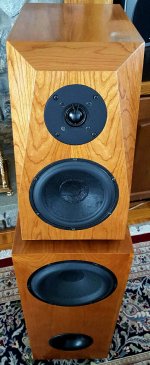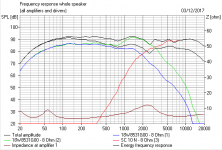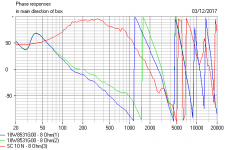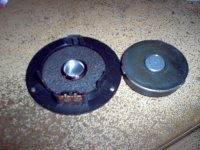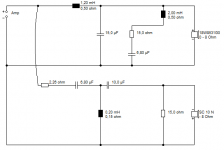I'd simply go as low as the tweeter could realistically handle. Maybe 1.6kHz or so, it depends on how loud you'd want the design to be able to go.
The newer ranges of scanspeak tweeters all have just 0.2mm of xmax. They all have low levels of distortion, especially the higher orders, but I'd really want to see how they'd cope when pushed to something like 100+dB down at 1400Hz before crossing there. I'm assuming -6dB of attenuation by 1400Hz, for a 4th order LW slope, allowing a nominal SPL of 106dB if tested at 100dB.
The Be Revelator driver is interesting and ridiculously priced. People seem to overlook the 9700/9900 tweeters these days. These tweeters are quite old in the tooth and everyone prefers newer toys and shiny dome materials. Still with more SD, more xmax and proven performance down low at high SPLS (superior to the newer drivers imo) they actually make more sense in a whole lot of designs with ~6" woofers.
The 97000 and 99000 tweeters are slightly are slightly more challenging to tame. I went with 98000 Aluminum dome. Smooth as metal domes get, may even rival Be. I replaced the 97000 with a 98000 in my Scan-Speak 8" 2.5-way Classic speakers.
As far as drivers go, I don't think one can get any smoother than the 18W/8531G as it's supposed to be the DIY dream speaker - easy on crossovers. No real nasties.
same here ...The 97000 and 99000 tweeters are slightly are slightly more challenging to tame. I went with 98000 Aluminum dome. Smooth as metal domes get, may even rival Be. I replaced the 97000 with a 98000 in my Scan-Speak 8" 2.5-way Classic speakers.
As far as drivers go, I don't think one can get any smoother than the 18W/8531G as it's supposed to be the DIY dream speaker - easy on crossovers. No real nasties.
I was sincerly thinking than the SS classic 91300 (the Peerless clone) was a smooth low end ideal fellow for the Rev mid.
But it seems not to be as easy below 2000/2500 Hz (or at the price of more distorsion). And you guys seem to favor a max XO at 2K with the mid Rev. A little below if possible...
With all your inputs I'm curious about the Ophelia choice now of the (expensive) Be... just trendy perhaps ? Saw T Gravsen went the opposite way : illuminator mid woof (though not as big than the Ophelia as it's a 4") and the the "cheap" Peerless clone for the tweeter !
I'm looking forward to read the listening review of the OP about the finished Ophelia cause he has/had many kits around SS drivers at hands ! 🙂
But it seems not to be as easy below 2000/2500 Hz (or at the price of more distorsion). And you guys seem to favor a max XO at 2K with the mid Rev. A little below if possible...
With all your inputs I'm curious about the Ophelia choice now of the (expensive) Be... just trendy perhaps ? Saw T Gravsen went the opposite way : illuminator mid woof (though not as big than the Ophelia as it's a 4") and the the "cheap" Peerless clone for the tweeter !
I'm looking forward to read the listening review of the OP about the finished Ophelia cause he has/had many kits around SS drivers at hands ! 🙂
You're refering to Troel's Ekta 2 speaker. Drivers are excellent, except that I'm not a fan of 91300 ferrofluid tweeter for the long-term. The ferrofluid inside tweeters dry out after 20-25 years and the tweeter will not work. I found this out with my childhood parent's speakers... Good luck trying to find a replacement, long after Scan-Speak discontinues it should you have to change it down the road.I was sincerly thinking than the SS classic 91300 (the Peerless clone) was a smooth low end ideal fellow for the Rev mid.
But it seems not to be as easy below 2000/2500 Hz (or at the price of more distorsion). And you guys seem to favor a max XO at 2K with the mid Rev. A little below if possible...
With all your inputs I'm curious about the Ophelia choice now of the (expensive) Be... just trendy perhaps ? Saw T Gravsen went the opposite way : illuminator mid woof (though not as big than the Ophelia as it's a 4") and the the "cheap" Peerless clone for the tweeter !
I'm looking forward to read the listening review of the OP about the finished Ophelia cause he has/had many kits around SS drivers at hands ! 🙂
Troel's used to offer tweeter choices with his designs which was great. You may have the midrange and woofer from another speaker, but now you'll have to buy a new tweeter for a one-time application.
Choosing 2k-2.5k mid/tweeter crossover frequency is not arbitrary. I look for:
1. Cone break frequencies of midrange. Want to keep clear of 3-6kHz (driver dependent).
2. Beaming of the midrange. This is analagous to the shut in sound that you get when cupping your hands around the mouth. Shallower cones benefit more than deeper cones.
3. Transition from 6/7" cone area to 1" has consequences sonically and in dispersion characteristics.
4. Roll-off (1st, 2nd, 3rd order, etc.)
I have 4 of the 714000 tweeters. One pair is for the ATS-4 which I'll get to next spring, and the other pair for the Ophelia. I've decided to build it since no else in the U.S.A. has. I'm using Mundorf Supreme for C1, Mundorf Silver Oil for C2, and Jupiter Copper for C3. This combination should render a spacious, clear, extended, smooth sound, with rich harmonic overtones. Once I'm done, I'll post it here...
Ha, should the speaker sound like crap, I'll use the 18W/8531G woofers in an Ekta Grand.
BTW, here's a photo of the 98000 tweeter in action on my Scan-Speak 8" 2.5-ways.
Attachments
Last edited:
Ferrofluid is easy enough to replace in a tweeter with a replaceable voicecoil:
Ferrofluid 100uL General Purpose for 1" Diameter V.C.
This whole thing is a bit suspect to me:
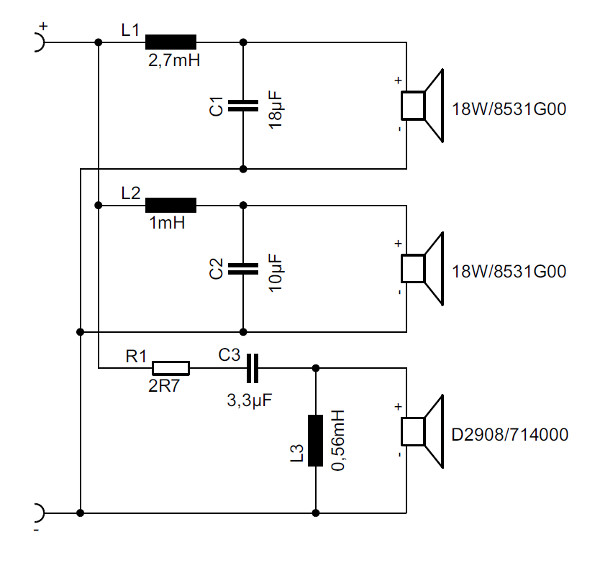
I don't get an impedance anything like this:
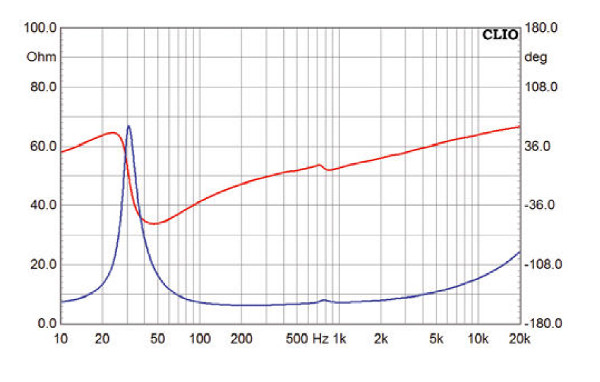
And the frequency response is suspiciously flat.
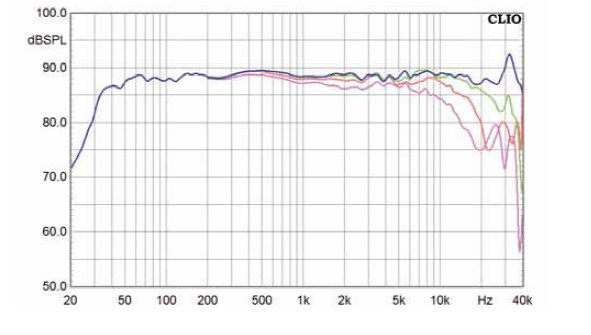
I had to redo the tweeter filter for a more conventional flat tweeter here so the impedance is slightly different, but this is what I got. And it was negative polarity too and tending to Butterworth. For sure it has a better crossover point than some others, and the 2.5 way helps a bit with the bumps.
Ferrofluid 100uL General Purpose for 1" Diameter V.C.
This whole thing is a bit suspect to me:
I don't get an impedance anything like this:
And the frequency response is suspiciously flat.
I had to redo the tweeter filter for a more conventional flat tweeter here so the impedance is slightly different, but this is what I got. And it was negative polarity too and tending to Butterworth. For sure it has a better crossover point than some others, and the 2.5 way helps a bit with the bumps.
Attachments
I got nothing personally against Madisound but I personally wouldn't build any speakers there. They just seem to be too arbitrary designed for flat freq. response.
I think you'll find this is a Klang + Ton kit, Andy. It's actually a reflex and the initial posted impedance curve here and above is wrong.
I think you'll find this is a Klang + Ton kit, Andy. It's actually a reflex and the initial posted impedance curve here and above is wrong.
I personally don't like complicated xover but the posted xover looks a bit raw like not fine tune ... well sometimes it works but a lot of times they don't quite have the right balance.
Ferrofluided two pairs of 20 & 30 years tweeters : FF from Ferrotec as often. I bought mine from Queensland speaker repair in Aussie (EBay) : serious shop, several choices of FF, not expensive ! with a single kit I refluided two pairs !
Ony problems is you never find the exact same formula than the genuine FF of the tweeters as Ferrotec USA has a big choice, most are not sold for repair !
Find Troels more and more goes for little mids between 4" & 5" ! Dunno if it's because he experienced a lot with 6" +1" from a long time now.
Ony problems is you never find the exact same formula than the genuine FF of the tweeters as Ferrotec USA has a big choice, most are not sold for repair !
Find Troels more and more goes for little mids between 4" & 5" ! Dunno if it's because he experienced a lot with 6" +1" from a long time now.
Last edited:
Thanks Steve for chiming in! It does look suspicious. I don't have the CLIO software to vouch for any of this. I'd be skeptical over the 4.5kHz bump response curve which is inherent to the 714000 tweeter. Tony G has addressed with baffle geometry. Troels has dealt with by shunting a cap on the series R altering the phase to smoothen the frequency curve and by placing the tweeter 18mm behind the woofer in his ATS-4.Ferrofluid is easy enough to replace in a tweeter with a replaceable voicecoil:
Ferrofluid 100uL General Purpose for 1" Diameter V.C.
This whole thing is a bit suspect to me:

I don't get an impedance anything like this:

And the frequency response is suspiciously flat.

I had to redo the tweeter filter for a more conventional flat tweeter here so the impedance is slightly different, but this is what I got. And it was negative polarity too and tending to Butterworth. For sure it has a better crossover point than some others, and the 2.5 way helps a bit with the bumps.
I'd be curious how Ophelia's front baffle geometry will impact the measured frequency response. I dont know if K + T tested different front baffles and chose the one that renders the smoothest response. That's where the tire will meet the road. No sim can predict measured response.
As for ferrofluid replacement. Good luck trying to put back everything and have it perform to spec and be matched. Besides mine was stamped shut - "Made in Taiwan." Seems passe to go through the aggravation and effort when so many other tweeters can outperform FF types nowadays.
Last edited:
The 3.3uF and 0.56mH is actually the sort of thing you'd use with a waveguide tweeter. The Be dome does seem to have a response like that, so I'd think it is quite accurate.
In the UK, you can buy this little ferrofluid kit which I found is good for 5 tweeters like my SEAS 19TAF/G which had gone solid. Parts Express are supplying too small a kit, IMO.
Sonitus Audio Ferro Fluid (ferrofluid) for Speakers and Compression Drivers 0.5ml PS5.00 IN STOCK (3 Dec 2017)
Here's the magic notch, BTW. I am always generous with ideas.
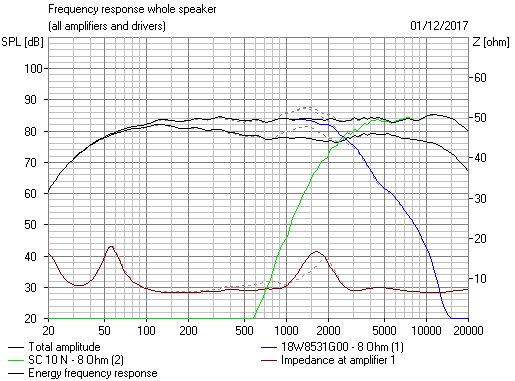
I have rarely seen something that works so specifically and well! That flat response is a Monitor voicing. In practice, in a lively room, you might slope it down a bit. 😎
In the UK, you can buy this little ferrofluid kit which I found is good for 5 tweeters like my SEAS 19TAF/G which had gone solid. Parts Express are supplying too small a kit, IMO.
Sonitus Audio Ferro Fluid (ferrofluid) for Speakers and Compression Drivers 0.5ml PS5.00 IN STOCK (3 Dec 2017)
Here's the magic notch, BTW. I am always generous with ideas.
I have rarely seen something that works so specifically and well! That flat response is a Monitor voicing. In practice, in a lively room, you might slope it down a bit. 😎
Attachments
Last edited:
Find Troels more and more goes for little mids between 4" & 5" ! Dunno if it's because he experienced a lot with 6" +1" from a long time now.
It depends on his design as he still uses 6in for a lot of his 3way designs. But definitely 6+1 is a compromise as he probably found out from his numerous 6+1 designs.
Thanks Steve for chiming in! It does look suspicious. I don't have the CLIO software to vouch for any of this. I'd be skeptical over the 4.5kHz bump response curve which is inherent to the 714000 tweeter. Tony G has addressed with baffle geometry. Troels has dealt with by shunting a cap on the series R altering the phase to smoothen the frequency curve and by placing the tweeter 18mm behind the woofer in his ATS-4.Ferrofluid is easy enough to replace in a tweeter with a replaceable voicecoil:
Ferrofluid 100uL General Purpose for 1" Diameter V.C.
This whole thing is a bit suspect to me:

I don't get an impedance anything like this:

And the frequency response is suspiciously flat.

I had to redo the tweeter filter for a more conventional flat tweeter here so the impedance is slightly different, but this is what I got. And it was negative polarity too and tending to Butterworth. For sure it has a better crossover point than some others, and the 2.5 way helps a bit with the bumps.
I'd be curious how Ophelia's front baffle geometry will impact the measured frequency response. I dont know if K + T tested different front baffles and chose the one that renders the smoothest response. That's where the tire will meet the road. No sim can predict measured response.
As for ferrofluid replacement. Good luck trying to put back everything and have it perform to spec and be matched. Besides mine was stamped shut - "Made in Taiwan." Seems passe to go through the aggravation and effort when so many other tweeters can outperform FF types nowadays.
True, 1.4KHz is probably pushing it a bit. I don't need as much headroom as some people (can't use it in this house) so can get away with taking the filters a bit lower. Not ideal for everyone of course.
Exactly the same here. I could crank it if I wanted to I just find that these days I do not want to.
Some people have very large rooms to fill and genuinely play at headbang levels a lot of the time. Most of us do not and I'd rather go with a better overall design + low xover on the tweeter, than design for the minority.
It'd be interesting to see how the Be Scan under discussion would behave when pushed beyond its xmax. Some start to buzz and produce a whole number of unpleasant sounds - not good. I'd hope that this Scan would only show high levels of 2nd order with everything else out of harms way.
Even with a low xover I think you'd be hard pressed to destroy one, which is really all I'd be concerned with as a designer for a commercial product. You turned it up so loud that it sounds bad? Turn it down. You turned it up and the tweeter melted, now we have a problem.😀
The 3.3uF and 0.56mH is actually the sort of thing you'd use with a waveguide tweeter. The Be dome does seem to have a response like that, so I'd think it is quite accurate.
In the UK, you can buy this little ferrofluid kit which I found is good for 5 tweeters like my SEAS 19TAF/G which had gone solid. Parts Express are supplying too small a kit, IMO.
Sonitus Audio Ferro Fluid (ferrofluid) for Speakers and Compression Drivers 0.5ml PS5.00 IN STOCK (3 Dec 2017)
Here's the magic notch, BTW. I am always generous with ideas.

I have rarely seen something that works so specifically and well! That flat response is a Monitor voicing. In practice, in a lively room, you might slope it down a bit. 😎
After a long break, I’ve resumed the Ophelia. Question:
1. Do I add the notch filter to both woofers, or just the 2kHz low-pass woofer?
2. Do the values of the low pass L and C change with the addition of a notch filter?
I still can’t believe nobody has ever posted the Ophelia build yet...
Many thanks everyone!
Attachments
... Has anyone built these?? Over 3 years, and I can’t believe not a single person on the internet has built these speakers, not even Scan-Speak! If anyone has, I’d love to hear from your experiences...
Perhaps you could make a single cabinet to test drive this Ophelia project and draw your conclusions from there. At least that is what I would do if it were me.
Good idea, Lojzek. Test cabs might be the way to go. This way I don’t have to waste too much time and material. It’s just seems odd that no one has built this published speaker system. It’s not like the drivers are obsolete.
did you build an ophelia speaker? I wonder if it's worth the effort and money. this
You're refering to Troel's Ekta 2 speaker. Drivers are excellent, except that I'm not a fan of 91300 ferrofluid tweeter for the long-term. The ferrofluid inside tweeters dry out after 20-25 years and the tweeter will not work. I found this out with my childhood parent's speakers... Good luck trying to find a replacement, long after Scan-Speak discontinues it should you have to change it down the road.
Troel's used to offer tweeter choices with his designs which was great. You may have the midrange and woofer from another speaker, but now you'll have to buy a new tweeter for a one-time application.
Choosing 2k-2.5k mid/tweeter crossover frequency is not arbitrary. I look for:
1. Cone break frequencies of midrange. Want to keep clear of 3-6kHz (driver dependent).
2. Beaming of the midrange. This is analagous to the shut in sound that you get when cupping your hands around the mouth. Shallower cones benefit more than deeper cones.
3. Transition from 6/7" cone area to 1" has consequences sonically and in dispersion characteristics.
4. Roll-off (1st, 2nd, 3rd order, etc.)
I have 4 of the 714000 tweeters. One pair is for the ATS-4 which I'll get to next spring, and the other pair for the Ophelia. I've decided to build it since no else in the U.S.A. has. I'm using Mundorf Supreme for C1, Mundorf Silver Oil for C2, and Jupiter Copper for C3. This combination should render a spacious, clear, extended, smooth sound, with rich harmonic overtones. Once I'm done, I'll post it here...
Ha, should the speaker sound like crap, I'll use the 18W/8531G woofers in an Ekta Grand.
BTW, here's a photo of the 98000 tweeter in action on my Scan-Speak 8" 2.5-ways.
Did you build an ophelia speaker?
I wonder if it's worth the effort and money. This speaker was shortlisted for me to build. It's hard to make a decision, I can't hear it before construction.
I only heard 18W / 8531t00, in a dayens "grande piccolo" speaker.
Any information and comment will be important to me.
I wonder if it's worth the effort and money. This speaker was shortlisted for me to build. It's hard to make a decision, I can't hear it before construction.
I only heard 18W / 8531t00, in a dayens "grande piccolo" speaker.
Any information and comment will be important to me.
- Home
- Loudspeakers
- Multi-Way
- Scan-Speak Ophelia: "Revelator" Speakers
